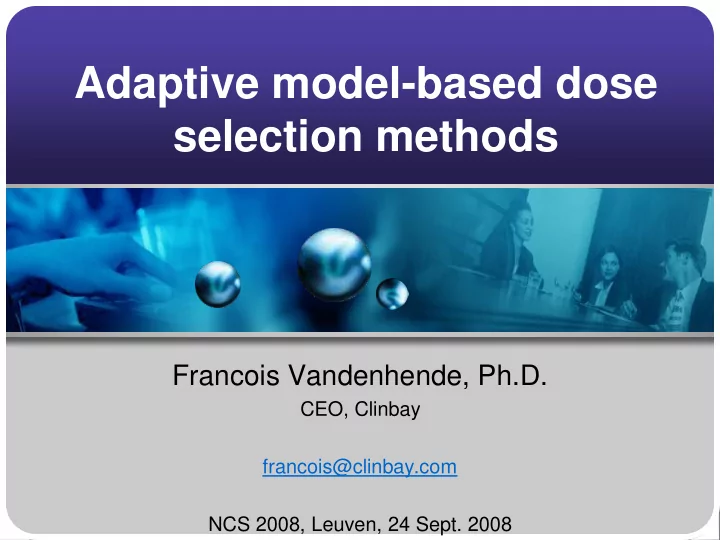

Adaptive model-based dose selection methods Francois Vandenhende, Ph.D. CEO, Clinbay francois@clinbay.com NCS 2008, Leuven, 24 Sept. 2008
Outline Adaptive modelling strategy Background and example Principles and components Analysis of a case study Conclusions
Proof of mechanism Preclinical Phase I Phase II Phase III Launch Efficacy Tox/Biology First in man POM Registration trials Dose ranging • Evidence of pharmacological activity • Early go/no go • Optimized dose selection for phase II • Challenges: – Availability of a validated biomarker – Cost effectiveness – Predictivity
Example: Receptor Occupancy PET Tracer Blocking scan Blocking scan Baseline scan 5 mg drug 20mg drug Drug 50% Occupancy 75% Occupancy
Dose-Occupancy Relationship No occupancy : Quick kill Dose selection: Quantiles of dose-response J. Meyer et al., [C-11]DASB uptake before and after SSRI, Toronto.
Adaptive Modelling Strategy • Parametric dose-response model RO ( , ) f dose – E.g., Emax model or 4PL • Bayesian inference ( | ) ( ) ( | ) p RO p L RO – Uses available prior information p( θ ) from preclinical assays or competitors. – Posterior update possible after every subject
Adaptive Modelling Strategy (II) • Adaptive dose selection during study: – Select next dose dz that optimizes a property of p ( | , ) RO hist RO dz – E.g., D-optimal design: min |Var( θ )| • Decision to stop POM trial – Stop enrolment when • Precision around f(dose, θ ) is sufficient, or • For futility, when, eg: Pr[f(dose, θ )>50%]<5%.
Adaptive Modelling Strategy (III) • Predicting relevant doses for phase II: – Based on posterior predictive distribution: ( | ) ( | , ) ( | ) p RO RO p RO RO p RO d patient patient POM POM POM – E.g.: ( 70 % | ) 90 % p RO RO patient POM ( 70 % | ) 50 % p RO RO patient POM ( 70 % | ) 10 % p RO RO patient POM
DASB Case Study Design and analysis settings: Emax model (flat priors) Next dose: D-optimal Stop study if CV(ED50)<30% or Pr[Emax<50%]>95%. Phase II doses based on PP(RO>70%) www.decimaker.com
Emax model and Priors
Bayesian Emax model fit Param mean sd 2.5% median 97.5% Emax 85.82 5.191 76.54 85.47 97.06 ED50 2.199 0.539 1.39 2.154 3.398 tau 0.022 0.011 0.006 0.021 0.046
Next dose and stopping rules
Dose selection for Phase II Clinbay 2007 - Confidential Next Patient RO>70%?
Conclusions • Adaptive modelling strategy permits quantitative, data-driven decisions: – Within study: • Dose selection • Trial termination – Across drug development: • Probability of failure (success) drives go/no go decisions • Summary of all historical data • Prediction of future patient responses • Technical challenges when using quantitative methods: – More work upfront on definition of decision tree. – Trial simulations to validate strategy. – Software availability as a key enabler.
Thank you! Any Question? www.clinbay.com
Recommend
More recommend